Want better results from your Facebook advertising? Wondering how to reach more people who look like your top customers?
In this article, you'll discover how to create and scale high-intent lookalike audiences with Facebook ads.
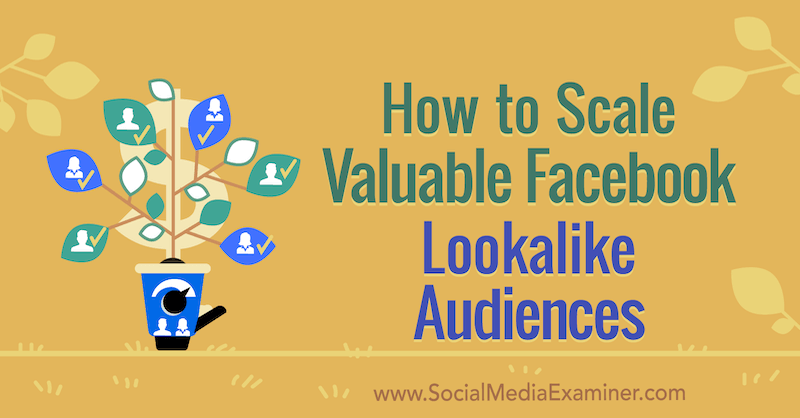
Why Increasing the Lookalike Percentage Doesn't Work for Scaling
Facebook lookalike audiences let you reach a large number of people who share the same characteristics as your existing customers. But how do you scale your lookalike audiences without damaging their quality?
While using a larger lookalike percentage could help you reach more people, those people would end up being less similar to your seed audience, and therefore less likely to convert. In other words, increasing the reach would come at the expense of your audience's quality.
When you increase the lookalike percentage, you may reach a point where the audience becomes so large that it's similar to a broad audience with no targeting at all. In this case, you're not helping Facebook narrow down the target audience and are relying more on the algorithm to laser-target your prospects within a huge audience pool. While this could work for large accounts with a lot of data, it isn't leveraging the full power of lookalike audiences.

A ‘super' lookalike audience, on the other hand, has the advantage of both size and quality. It's a combination of different lookalikes—each of which holds very similar characteristics to the custom audience it's based on—that you target within a single ad set.
A super lookalike maximizes Facebook's lookalike capabilities. Facebook's algorithm gets better and more accurate by the day but when you narrow down and specify the characteristics of your desired audience, you help Facebook do an even better job and get better results.
Due to the high relevance of the super lookalike, it provides a higher click-through rate and a higher rate of conversion while improving your relevance score. Facebook will then reward these audiences with a lower CPM (cost per thousand impressions), which improves the overall performance of the ad set.
This method works for basically every industry because it relies on Facebook's lookalike data module, which works across the board. And the more data you have, the better it will work. The most important data points you need are a large variety of high-performing custom audiences and a significant amount of historical data about high-performing lookalike audiences.
Note: This article assumes you've installed the Facebook pixel and event tracking. Watch this video for step-by-step instructions for installing the pixel and read this article to learn how to set up event tracking with the Facebook Event Setup tool.
Now we'll look at how to set up and scale high-intent lookalike audiences to target with your Facebook ads.
#1: Create Facebook Custom Audiences of Top Customers
The quality of your custom audience is crucial to creating a solid performance-driving lookalike audience. You want to focus on your most valuable customers, and therefore create custom audiences based on bottom-of-the-funnel conversion events.
Get World-Class Marketing Training — All Year Long!
Are you facing doubt, uncertainty, or overwhelm? The Social Media Marketing Society can help.
Each month, you’ll receive training from trusted marketing experts, covering everything from AI to organic social marketing. When you join, you’ll also get immediate access to:
- A library of 100+ marketing trainings
- A community of like-minded marketers
- Monthly online community meetups
- Relevant news and trends updates
You can create custom audiences based on your Facebook pixel data, targeting people who have completed different conversion events on your website.
Another option for focusing on your best customers is to create a value-based custom audience. To create this audience, you use your customer list and add an arbitrary number to each customer, representing their lifetime value to your business. You simply upload this list to Facebook and create your audience based on it.
Keep in mind that you'll need to update your customer list regularly to keep this audience relevant for your business. Creating this value-based audience using your pixel data will save you a bit of trouble because your customer data will be updated automatically.
Moreover, in a recent update, Facebook added the option to turn every one of your pixel-based lookalike audiences into a value-based one with the click of a button.
Other valuable custom audiences that advertisers tend to overlook are people who spend time on your product pages, your top spenders (one of the most powerful value-based audiences), and people who watched 75% or 95% of your video.
For eCommerce, I recommend starting with custom audiences based on high-intent events that take place on your website:
- Purchase
- Initiate checkout
- Add payment info
- Add to cart
To create these website-based custom audiences, make sure you have the Facebook pixel installed on your website and that it identifies these specific events.
Once you have this in place, go to Audiences in Facebook Ads Manager to create your first custom audience. Click the Create Audience drop-down menu and select Custom Audience.
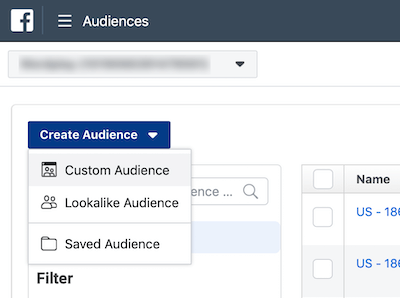
In the Create a Custom Audience window, choose Website as the source.

On the next screen, select your Facebook pixel and use the drop-down menu to choose your desired event. Then add a name and click Create Audience.
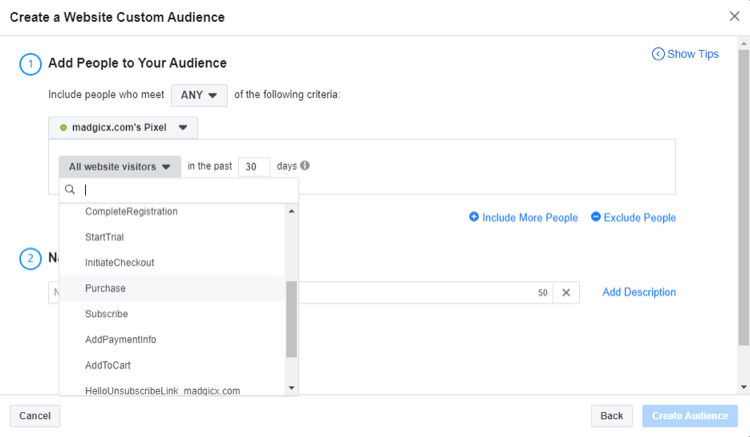
When you're finished creating your first audience, repeat the above steps to create the other three custom audiences.
Keep in mind that while these custom audiences might overlap, the final lookalikes will end up being big and diverse enough that the overlap won't hinder your campaigns. Additionally, all of these lookalikes will be targeted within the same ad set so you don't have to worry about your ad sets competing against each other by targeting the same audience.
Combining audiences of people who are likely to purchase, initiate checkout, add payment info, and add to cart will get you one large audience that includes users who are highly likely to take several high-intent actions on your website. This is the power of the super lookalike audience you'll set up.

Discover Proven Marketing Strategies and Tips
Want to go even deeper with your marketing? Check out the Social Media Marketing Podcast! Publishing weekly since 2012, the Social Media Marketing Podcast helps you navigate the constantly changing marketing jungle, with expert interviews from marketing pros.
But don’t let the name fool you. This show is about a lot more than just social media marketing. With over 600 episodes and millions of downloads each year, this show has been a trusted source for marketers for well over a decade.
#2: Identify Top Custom Audiences to Seed ‘Super' Lookalike Audiences
The next step is to identify your top-performing custom audiences according to your key performance indicators (KPIs). You'll then create low-percentage lookalikes from each of your best custom audiences and target them in the same ad set. Each of these ‘blended' lookalike audiences will be a super lookalike audience.
To identify your current top-performing ad sets, open Facebook Ads Manager and go to the Ad Sets tab. Add a column for your most important metric (ROAS, for instance) and sort the list by it.

After you've identified your top ad sets, find out which audiences are behind them. To do this, click Edit under the ad set name.
Then scroll down to the Audience section and note the audience name. Repeat this process for each of your top ad sets to compile a list of your top-performing custom audiences.

Now go to Audiences in Ads Manager to create low-percentage lookalikes based on each of your top custom audiences. Select your first custom audience and click the button with the three dots. Choose Create Lookalike from the drop-down menu.
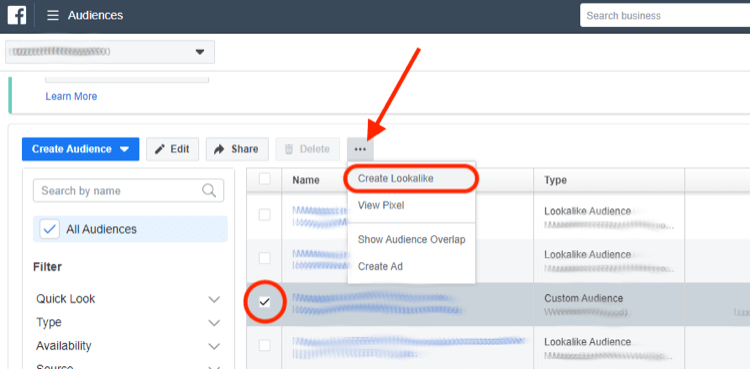
I recommend that you use 0%–3% lookalike audiences, depending on your target country.

Now combine the lookalike audiences you just created and start testing them to find the top-performing super lookalikes. To do this, launch three to five ad sets, each of which will target a different combination of 3–15 lookalike audiences (your super lookalike audiences).

#3: Four Ways to Scale Your Lookalike Audiences
Getting great results early on will allow you to vertically scale your super lookalike audience by increasing budgets.
Once you max out the audience, you can horizontally scale it by applying the same methods used for creating the super lookalike audience:
Different Lookalike Percentages
Try creating lookalikes from the same seed audience using different percentages—2%, 5%, and 10%, for example.
Pro Tip: When testing different lookalike percentages, don't exclude the smaller-percentage audiences you used previously. The reason is that the audience is so large that even if there will eventually be some overlap, it would be negligible, especially when considering the auction overlap. Therefore, there's no need to exclude your best audiences that have already proven to deliver high performance.
Different Seed Audiences
The more audiences you can test, the better. Start with strong audiences and use all of your data. I recommend testing these audiences:
- Website visitors: Start with visitors who performed high-intent events (as outlined above) and then progress to visitors who performed lower-intent events like page view, view content, and so on.
- Social page data: People who have engaged with your Facebook page, Instagram business profile, or other presence.
- Ad engagers: People who have saved or engaged with your ads.
- Email list: People who have bought from you directly on Facebook or somewhere else.
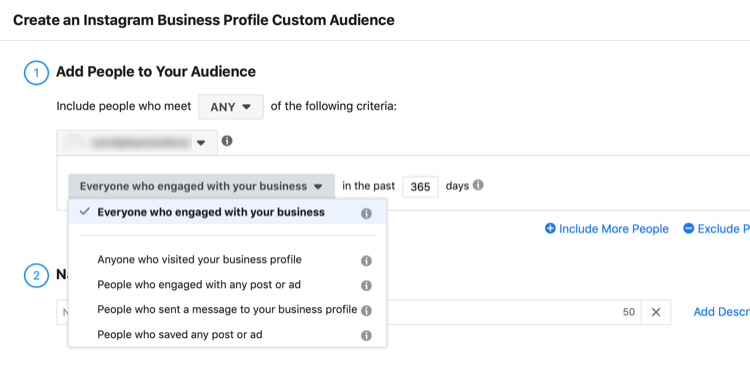
Different Recency of Data
When creating custom audiences of Facebook page engagers, Instagram business profile engagers, and ad engagers—as well as video viewers—you can extend the time frame to include data from the past 365 days.
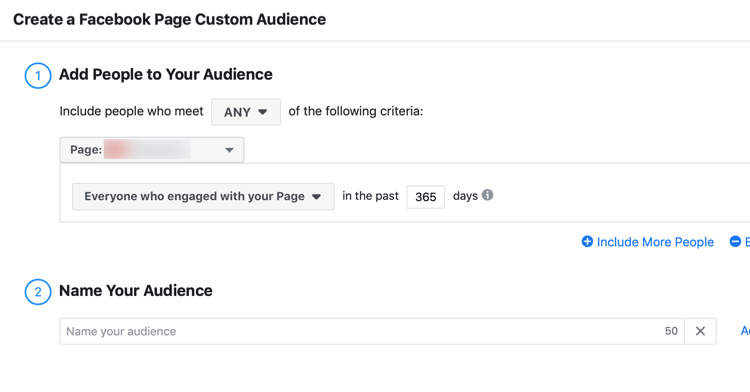
For website visitors, you're limited to a maximum time frame of the past 180 days; therefore, I recommend you also add a custom audience with your all-time purchase data. You can do this by uploading your email list to Facebook.
When testing different recency of data, split the days into various data sets. Ideally, test data from the past 7, 14, 30, 60, 90, 180, and 365 days (when possible).
Different Countries and Regions
Try to create lookalike audiences in different countries and regions. Start with your best-performing countries and expand farther. You can also combine multiple countries or locations within a single seed audience (but don't combine low- and high- CPM regions).
If you're marketing worldwide, a good combination is the largest English-speaking countries: U.S., UK, Canada, Australia, and New Zealand.
On top of all of these options, when scaling, try to mix all of these different variations. You can either play with one element (country, recency, etc.) at a time or with all of them at once.
Pro Tip: After testing your super lookalike audiences with low budgets using ad set budget optimization, you can use Campaign Budget Optimization (CBO) and launch four or five different ad sets, each containing four super lookalike audiences. CBO works best with larger audiences so you can use slightly higher-percentage lookalike audiences at this stage.
Conclusion
Super lookalike audiences work best when they're created based on real data (which you may already have in your account). The more data you have, the better your super lookalike audience will work, which will improve your Facebook ad performance.
The “secret sauce” of super lookalike audiences is utilizing all of your possible data sets to create an extremely high-quality audience in terms of relevance. At the same time, this method keeps it large enough for Facebook to run it through its algorithm and work its magic.
Not a lot of advertisers are currently using this approach so it's an opportunity for you to stay ahead of the competition. Create more ad sets leveraging super lookalike audiences to get better returns on your ad spend.
What do you think? Will you try targeting high-intent super lookalike audiences with your Facebook ads? Share your thoughts in the comments below.
More articles on Facebook ads:
- Find seven ways to target website visitors with Facebook custom audiences.
- Learn how to reduce your Facebook ad spend with smart targeting.
- Discover six Facebook advertising mistakes and how to fix them.
Attention Agency Owners, Brand Marketers, and Consultants

Introducing the Marketing Agency Show–our newest podcast designed to explore the struggles of agency marketers.
Join show host and agency owner, Brooke Sellas, as she interviews agency marketers and digs deep into their biggest challenges. Explore topics like navigating rough economic times, leveraging AI, service diversification, client acquisition, and much more.
Just pull up your favorite podcast app, search for Marketing Agency Show and start listening. Or click the button below for more information.

